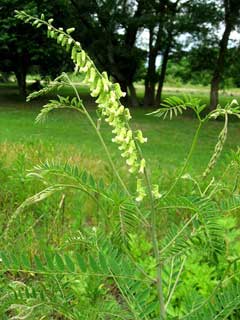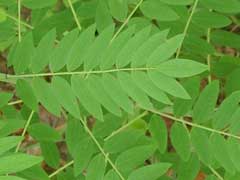 |
|
|
 |
| http://commons.wikimedia.org/wiki/User:Dalgial |
Translate this page:
Summary
Physical Characteristics

 Sophora flavescens is an evergreen Shrub growing to 1.5 m (5ft) by 1 m (3ft 3in) at a slow rate.
Sophora flavescens is an evergreen Shrub growing to 1.5 m (5ft) by 1 m (3ft 3in) at a slow rate.
See above for USDA hardiness. It is hardy to UK zone 6. It is in leaf all year, in flower from July to August, and the seeds ripen in September. The species is hermaphrodite (has both male and female organs) and is pollinated by Insects.
It can fix Nitrogen.
Suitable for: light (sandy), medium (loamy) and heavy (clay) soils and prefers well-drained soil. Suitable pH: mildly acid, neutral and basic (mildly alkaline) soils. It cannot grow in the shade. It prefers moist soil.
UK Hardiness Map
US Hardiness Map
Synonyms
S. angustifolia. Sieb.&Zucc.
Plant Habitats
Woodland Garden Sunny Edge;
Edible Uses
References More on Edible Uses
Medicinal Uses
Plants For A Future can not take any responsibility for any adverse effects from the use of plants. Always seek advice from a professional before using a plant medicinally.
Anthelmintic Antibacterial Antifungal Antipruritic Astringent Bitter Carminative Diuretic
Dysentery Eczema Febrifuge Leprosy Parasiticide Parasiticide Pectoral
Stomachic Tonic Urinary
The root is anthelmintic, antibacterial, antifungal, antipruritic, astringent, bitter, carminative, diuretic, febrifuge, parasiticide, pectoral, stomachic and tonic[61, 147, 174, 176, 178, 218, 279]. It is used internally in the treatment of jaundice, dysentery, diarrhoea and urinary infections[238]. It is used both internally and externally in the treatment of vaginitis, eczema, pruritis, ringworm, leprosy, syphilis, scabies and itching allergic reactions[238]. The root is harvested in the autumn and dried for later use[238]. The plant is anthelmintic and diuretic[218]. It also has antibacterial activity, inhibiting the growth of Mycobacterium tuberculosis and Trichomonas vaginitis[176, 218].
References More on Medicinal Uses
The Bookshop: Edible Plant Books
Our Latest books on Perennial Plants For Food Forests and Permaculture Gardens in paperback or digital formats.

Edible Tropical Plants
Food Forest Plants for Hotter Conditions: 250+ Plants For Tropical Food Forests & Permaculture Gardens.
More

Edible Temperate Plants
Plants for Your Food Forest: 500 Plants for Temperate Food Forests & Permaculture Gardens.
More

More Books
PFAF have eight books available in paperback and digital formats. Browse the shop for more information.
Shop Now
Other Uses
References More on Other Uses
Cultivation details
Succeeds in a well-drained moderately fertile soil in full sun[200]. Requires the protection of a sunny wall if it is to flower[182], and succeeds only in the mildest areas of the country. It grows best in the warmer areas of the country where the wood will be more readily ripened and better able to withstand winter cold[219]. Although hardy to at least -15°c[238], this species does not do very well in the relatively cool summers of Britain, the plant gradually weakens and eventually succumbs[11]. It can be grown in the milder areas of the country and be treated like a herbaceous perennial, growing afresh from the base each spring[233]. An important medicinal herb in China[61]. Plants should be container-grown and planted out whilst young, older plants do not transplant well[219]. A polymorphic species[58]. The flowers are produced on the current years growth[182]. Plants in this genus are notably resistant to honey fungus[200]. This species has a symbiotic relationship with certain soil bacteria, these bacteria form nodules on the roots and fix atmospheric nitrogen. Some of this nitrogen is utilized by the growing plant but some can also be used by other plants growing nearby[200].
References Carbon Farming Information and Carbon Sequestration Information
Temperature Converter
Type a value in the Celsius field to convert the value to Fahrenheit:
Fahrenheit:
The PFAF Bookshop
Plants For A Future have a number of books available in paperback and digital form. Book titles include Edible Plants, Edible Perennials, Edible Trees,Edible Shrubs, Woodland Gardening, and Temperate Food Forest Plants. Our new book is Food Forest Plants For Hotter Conditions (Tropical and Sub-Tropical).
Shop Now
Plant Propagation
Seed - best sown as soon as it is ripe in a greenhouse[200]. Pre-soak stored seed for 12 hours in hot (not boiling) water and sow in late winter in a greenhouse[78]. Prick out the seedlings as soon as they are large enough to handle into individual pots in the greenhouse, and grow them on for 2 years under protected conditions. Plant them out into their permanent positions in early summer of their third year. Cuttings of young shoots with a heel, July/August in a frame[11]. Air-layering[200].
Other Names
If available other names are mentioned here
Native Range
TEMPERATE ASIA: Mongolia (east), Russian Federation (Primorye, Amur), China, Korea, Japan, Taiwan
Weed Potential
Right plant wrong place. We are currently updating this section.
Please note that a plant may be invasive in one area but may not in your area so it's worth checking.
Conservation Status
IUCN Red List of Threatened Plants Status :

Growth: S = slow M = medium F = fast. Soil: L = light (sandy) M = medium H = heavy (clay). pH: A = acid N = neutral B = basic (alkaline). Shade: F = full shade S = semi-shade N = no shade. Moisture: D = dry M = Moist We = wet Wa = water.
Now available:
Food Forest Plants for Mediterranean Conditions
350+ Perennial Plants For Mediterranean and Drier Food Forests and Permaculture Gardens.
[Paperback and eBook]
This is the third in Plants For A Future's series of plant guides for food forests tailored to
specific climate zones. Following volumes on temperate and tropical ecosystems, this book focuses
on species suited to Mediterranean conditions—regions with hot, dry summers and cool, wet winters,
often facing the added challenge of climate change.
Read More
Expert comment
Author
Aiton.
Botanical References
74200266
Links / References
For a list of references used on this page please go here
Readers comment